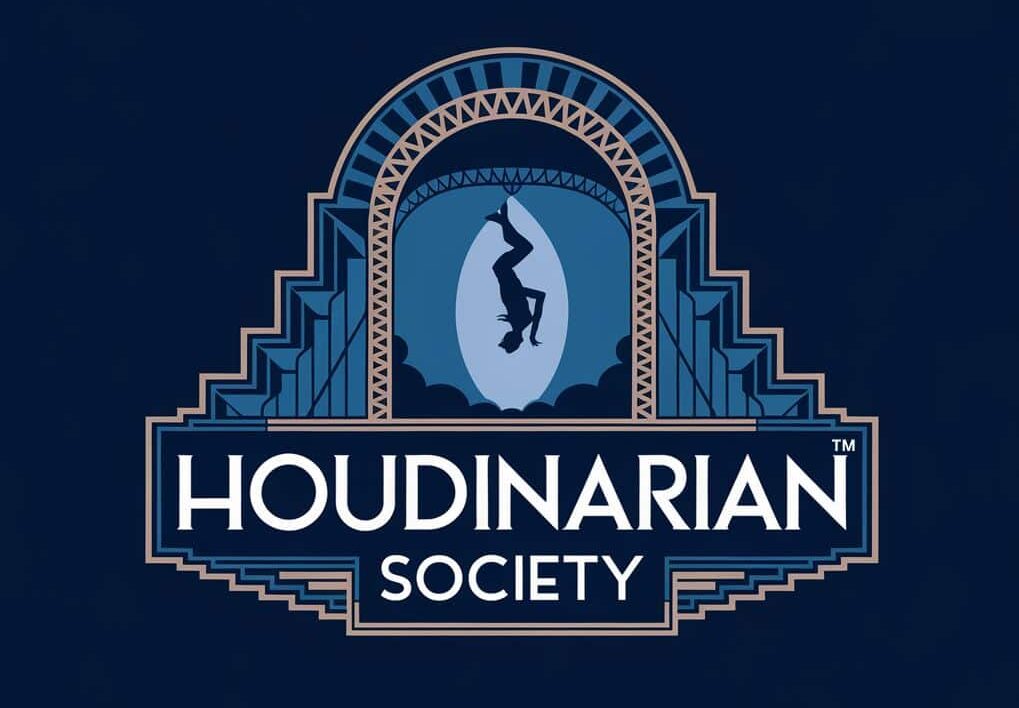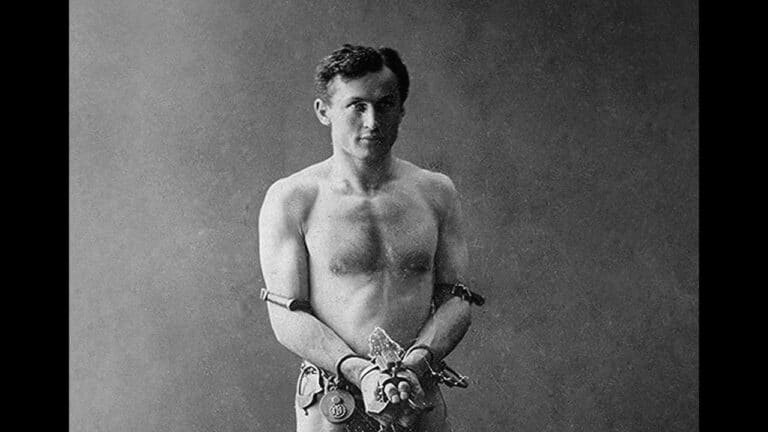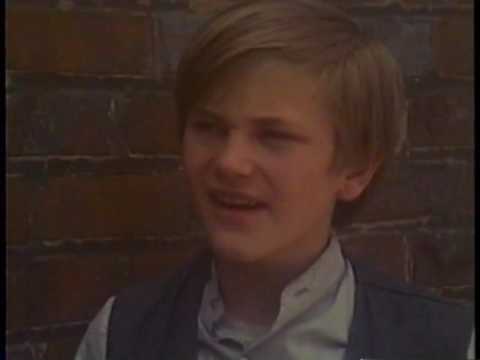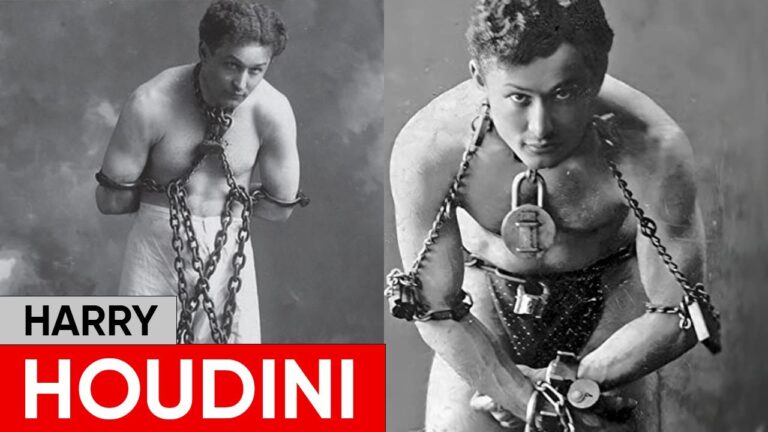The Evolution of Escape Tricks: How Houdini Redefined a Genre in Magic
Magic changed forever when Harry Houdini stepped onto the stage in the early 1900s. His revolutionary approach to escape artistry transformed simple magic tricks into theatrical masterpieces that captivated audiences worldwide.
Houdini elevated escape magic from basic handcuff releases to complex performances involving water torture cells and jail breaks, becoming the most famous performer of his time.
You might wonder what made Houdini’s escapes so special. He added drama and danger to every performance, turning simple handcuff escapes into spectacular events by jumping into rivers while chained or hanging upside down from tall buildings.
His genius lay in understanding that audiences wanted more than just tricks – they craved an emotional experience.
The legacy of Houdini’s innovations lives on today. Modern escape artists build on his foundation, using close-up magic techniques to create intimate experiences while maintaining the core elements of suspense and wonder that made his performances legendary.
The Origins of Escape Artistry

Escape artists have amazed audiences for centuries with their ability to break free from chains, locks, and other restraints. Their acts combine physical skill, mental fortitude, and showmanship to create unforgettable performances.
Early Examples of Escape Tricks
The first recorded escape acts emerged in European traveling shows during the late 1700s. These performances often featured simple rope ties and basic restraints.
Carnival performers would invite audience members to bind them with ropes, then free themselves in dramatic fashion. The tricks relied heavily on flexibility and clever misdirection.
Street performers in London and Paris popularized handcuff escapes in the 1850s. They challenged local police to restrain them with official equipment.
Key Figures Before Houdini
The Davenport Brothers gained fame in the 1860s for their spirit cabinet act. While tied inside a wooden cabinet, they appeared to summon spirits that would play musical instruments.
John Nevil Maskelyne revolutionized escape acts at Egypt Hall in London. His innovative “trunk escape” in 1880 inspired many future performers.
Robert-Houdin incorporated escape elements into his magic shows. His influence helped establish escapes as a legitimate branch of stage magic.
The Cultural Context of Early Escape Acts
Victorian audiences were fascinated by issues of confinement and freedom. The rise of modern police forces and secure prison systems sparked public interest in escape artistry.
Early escape artists performed behind screens, creating an air of mystery around their methods. This practice helped establish escape acts as a distinct form of entertainment.
Spiritualism and stage magic merged in many early performances. Escape artists often claimed supernatural powers to enhance their appeal.
The industrial revolution brought new restraints like steel handcuffs and padlocks. These tools gave performers fresh challenges to conquer.
Houdini’s Early Career and Influences

Erik Weisz, later known as Harry Houdini, started his journey in magic at a young age and quickly developed innovative escape techniques that would change entertainment forever.
Initial Forays Into Magic and Escape Tricks
Young Houdini began performing at age 17, doing small magic shows with his brother in music halls. His early acts focused on basic card tricks and sleight of hand.
In 1894, he married Beatrice Raymond (Bess), who became his stage assistant. Together, they performed as “The Houdinis” in various venues.
The duo perfected the famous “Metamorphosis” trick, where they switched places inside a locked trunk. This act became their signature piece during circus tours.
Influences and Inspirations
French magician Jean Eugène Robert-Houdin deeply influenced young Houdini – so much that he adopted a variation of the master magician’s name.
Dime museums and sideshows shaped his early performance style. You can see their influence in his dramatic presentation and showmanship.
Traditional handcuff acts inspired him to develop his escape artistry. He studied locksmithing to understand the mechanics behind different restraints.
Key Early Performances
The 1893 World’s Fair in Chicago marked a pivotal moment in Houdini’s career. He showcased his needle-swallowing trick, amazing crowds with this dangerous feat.
The Welsh Brothers Circus gave Houdini his first major platform. He and Bess performed song, dance, and magic while touring with the company.
His early handcuff escapes began drawing serious attention. You could see his unique style developing as he added dramatic elements to each performance.
Innovative Techniques and Methods

Houdini revolutionized escape artistry through groundbreaking methods that combined physical prowess, technical mastery, and psychological manipulation. His innovations forever changed how magicians approach both the mechanics and presentation of escapes.
Development of Signature Escapes
The Chinese Water Torture Cell became Houdini’s most famous creation. He designed this death-defying feat to hang upside-down in a glass tank filled with water, secured by stocks at the ankles.
His Milk Can Escape introduced another layer of tension by adding a time element. You would watch him take his final breath before being locked inside a water-filled metal container.
The Mirror Handcuff Challenge proved his mastery when he escaped a custom-made restraint by London’s Daily Mirror newspaper after 70 minutes of intense struggle.
Advances in Lock-Picking and Restraint Techniques
Houdini pioneered new methods for defeating locks and restraints. He used:
- Hidden lock picks in seams and hemlines
- Flexible steel tools concealed in his hair
- Custom-designed skeleton keys that could open multiple locks
He also mastered the art of dislocating his shoulders to slip out of straightjackets. This technique let him escape while hanging upside down from tall buildings.
The Role of Physical Conditioning and Training
Your body must become a tool for escape. Houdini trained rigorously with these essential skills:
- Holding his breath for up to 3 minutes underwater
- Developing extreme flexibility in his shoulders and joints
- Building core strength for inverted escapes
He practiced lock manipulation for hours daily. Regular ice baths helped him withstand the freezing waters during bridge jumps and river escapes.
His intense workout routine included running, swimming, and specialized exercises to maintain the physical condition needed for his most demanding stunts.
The Theatrical Transformation
Harry Houdini transformed magic from simple tricks into grand theatrical productions by combining dramatic escapes with expert stagecraft and storytelling.
Creating a Spectacle: Stagecraft and Presentation
Houdini knew your attention must be captured before a trick even began. He perfected his stage presence and timing through years of vaudeville performances.
His shows featured bright spotlights focused on the constraints – handcuffs, chains, and boxes. This lighting technique drew your eye exactly where he wanted it.
You would watch as he built tension through careful pacing. Sometimes he’d emerge triumphant in seconds. Other times, he’d stretch the suspense for 30 minutes or more.
Use of Props and Elaborate Setups
The handcuffs and chains became more than just restraints – they were characters in his performance. You’d see him test each lock, examine every link.
His most famous props included:
- The Chinese Water Torture Cell
- The Milk Can Escape
- The Suspended Straitjacket
Each prop was custom-built, polished to perfection, and designed to create maximum visual impact.
Incorporation of Storytelling and Drama
Performing with his wife Bess added a personal element to his shows. You’d feel the emotional connection as she watched his death-defying feats.
He crafted narratives around each escape. The Water Torture Cell wasn’t just a tank – it became a battle between life and death.
His promotional materials told stories of challenge and triumph. You’d read about police chiefs who tried to keep him confined, rival magicians who copied his methods, and skeptics he proved wrong.
Promotional Strategies and Publicity Stunts
Harry Houdini mastered the art of self-promotion through daring public stunts and clever media manipulation. His marketing genius turned simple magic tricks into headline-grabbing spectacles that drew massive crowds.
Mastery of Media and Public Relations
Houdini knew exactly how to capture press attention. He designed his routines specifically to draw crowds and fill theater seats later that evening.
He maintained relationships with newspaper editors and reporters in every city he visited. Before performances, he would send advance teams to plaster posters and generate buzz.
His publicity assistants distributed flyers during outdoor stunts, creating a direct link between free shows and paid performances.
Famous Public Escapes and Their Impact
The strait jacket escape became one of his most iconic publicity stunts. Suspended upside down from tall buildings, Houdini would writhe free while crowds gathered below.
His bridge jumps served as powerful promotional tools. These death-defying feats attracted thousands of spectators and guaranteed newspaper coverage.
Key Public Stunts:
- Milk can escape
- Buried alive challenge
- Prison cell breakouts
- Underwater box escapes
Building a Personal Brand
Houdini crafted a unique persona as the “Handcuff King” and escape artist extraordinaire. His name became synonymous with seemingly impossible feats.
You can see his brand-building genius in how he challenged local police departments to restrain him. Each successful escape reinforced his reputation as unbeatable.
He protected his brand fiercely, often exposing imitators and fake mediums to maintain his position as the world’s premier escape artist.
Psychological Elements and Audience Engagement
The bond between an escape artist and their audience goes far beyond simple entertainment. A masterful escape creates deep emotional investment through carefully crafted psychological manipulation and precise timing.
Understanding Audience Psychology
Magic offers an escape from reality, pulling you into a world where normal rules don’t apply. When you watch an escape artist, your mind battles between what you know is possible and what you’re witnessing.
The best performers tap into primal fears – being trapped, drowning, or running out of time. These fears create an instant emotional connection.
Your brain seeks logical explanations while simultaneously wanting to believe in the impossible. This internal conflict heightens engagement and makes successful escapes more impactful.
Creating Suspense and Tension
The psychological game between escape artist and audience requires perfect balance. You must believe both that escape is possible and that real danger exists.
Key elements of building tension:
- Visible struggle against restraints
- Clear time constraints
- Physical signs of strain
- Moments of apparent failure
The performer maintains control while appearing to lose it. Each failed attempt at escape increases your investment in the final outcome.
Interaction With the Audience
Close-up magic creates intimate connections between performer and viewer. You become part of the experience through direct involvement.
Common audience participation elements:
- Examining restraints before the escape
- Assisting with securing the performer
- Timing the escape
- Verifying no hidden tools or aids
When you personally verify the conditions, your stake in the outcome grows stronger. Your role as witness and participant makes the eventual escape more meaningful.
Legacy and Influence on Modern Magic
Harry Houdini’s revolutionary approach to escape artistry transformed magic forever. His methods, showmanship, and innovative marketing strategies created ripples that continue to shape performing arts today.
Houdini’s Impact on Subsequent Magicians
His innovative techniques and emphasis on showmanship set new standards for magicians worldwide. You can see his influence in the dramatic presentation style of modern performers.
His marketing genius taught future generations how to build a personal brand. He created publicity stunts by challenging local police departments and newspapers. These stunts are still emulated by modern magicians.
His dedication to exposing fraudulent mediums established a tradition of skepticism in magic. This commitment to honesty while entertaining helped legitimize magic as an art form.
Evolution of Escape Acts Post-Houdini
The Chinese Water Torture Cell inspired countless variations in modern escape acts. Modern performers add their own twists while maintaining the core elements of danger and suspense.
The late 20th century saw magic return to street performances. Artists like David Blaine created intimate versions of classic escape acts.
Technology has allowed for new types of escapes involving cars, glass boxes, and industrial equipment. These acts honor Houdini’s spirit while pushing boundaries with modern tools.
Modern Interpretations and Homages
Television specials frequently recreate Houdini’s most famous stunts. Each new generation of magicians puts their own spin on his classic escapes.
Contemporary performers combine Houdini’s methods with new technology. They create hybrid acts that bridge past and present.
Social media has created new platforms for escape artists to showcase their skills. You can find thousands of videos featuring magicians attempting Houdini-inspired challenges.
His name remains synonymous with impossibility and escape. When you hear someone called “the next Houdini,” you know they’ve achieved something extraordinary.





